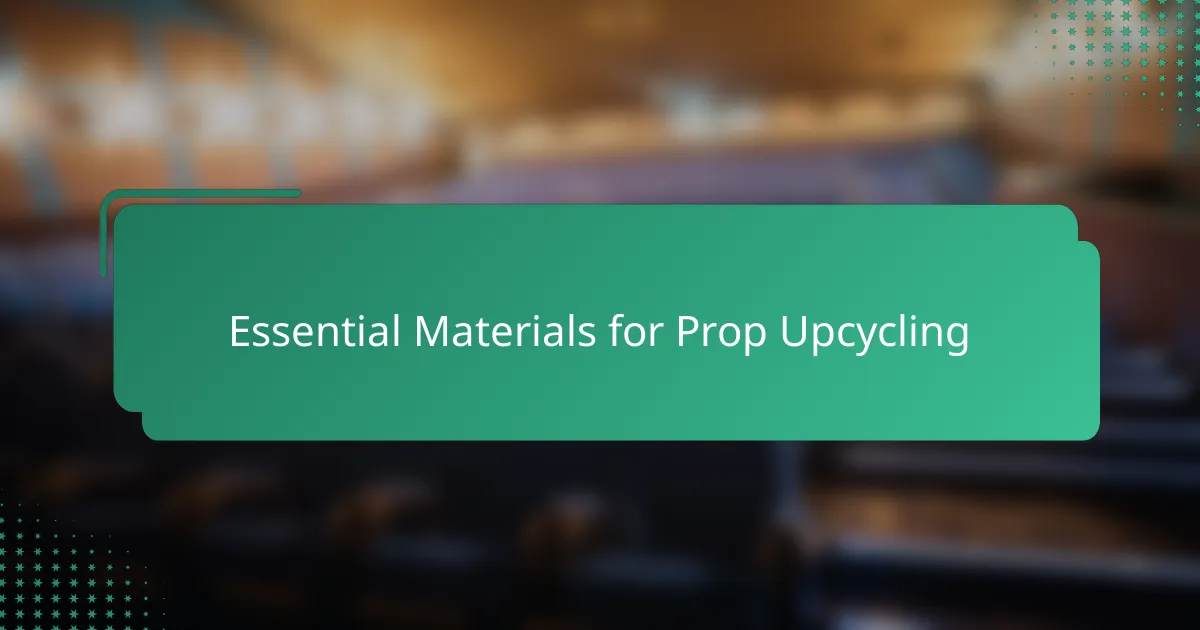Key takeaways
- Science fiction props transform everyday objects into imaginative pieces that enhance storytelling and immersion in fictional worlds.
- Essential materials for upcycling include basic supplies like glue and paint, along with specialty items like LED lights to add authenticity.
- The creative process involves careful selection of everyday items, thorough preparation, layering textures, and detailing to achieve realism.
- Effective showcasing of props enhances their impact, using lighting and context to tell a compelling story and surprise viewers with their origins.

Understanding Science Fiction Props
Science fiction props aren’t just random objects; they are the tangible pieces that bring an imagined universe to life. When I first encountered a prop that looked like it came from another world, I felt this immediate spark of curiosity—what stories could this object tell? It’s fascinating how these items, beyond their futuristic designs, act as storytellers themselves.
What makes a prop truly science fiction isn’t always the materials used but the creativity behind transforming everyday objects into something convincingly out of this world. I often ask myself: how can a simple gadget or kitchen utensil become part of a starship control panel or an alien artifact? This questioning fuels my passion for upcycling because the challenge pushes the boundaries of imagination.
Understanding the role of props in science fiction means recognizing their power to immerse, intrigue, and inspire. Have you ever noticed how a well-crafted prop can enhance a scene’s believability and your emotional connection to the narrative? That’s the magic I try to capture when I repurpose something familiar into a futuristic treasure.

Essential Materials for Prop Upcycling
When I first started upcycling everyday items into props, I quickly realized that having the right materials at hand makes all the difference. Basic supplies like glue, paint, and sandpaper may seem simple, but they hold the key to transforming the ordinary into something extraordinary. I still remember the thrill of seeing a worn-out plastic container turn into a sleek sci-fi communicator after a few coats of metallic spray paint and some careful sanding.
Tools like hot glue guns and scissors became my trusted companions during these projects. Without them, fusing different materials together or achieving smooth edges would have been a frustrating task. Have you ever tried to cut through thick plastic without the right scissors? Trust me, it’s a challenge that tests your patience more than your creativity.
Of course, specialty materials like LED lights and wires added that extra touch of authenticity to my creations. Adding a subtle glow or blinking effect can instantly make a prop feel alive—even if it started as a humble cereal box. These small details often sparked my favorite “aha” moments, when the prop truly began to tell its own futuristic story.

Choosing Everyday Items for Sci-Fi Props
Choosing which everyday items to transform is where the magic really begins. I often find myself rummaging through my kitchen drawers or junk drawer, asking, “Could this be a futuristic gadget or a piece of alien tech?” That moment of seeing potential in something mundane always excites me—it’s like uncovering treasure in plain sight.
I’ve learned to look for items with interesting shapes, textures, or materials because they give me a unique starting point. For example, a simple power adapter cover suddenly becomes so much more when I imagine it as a control dial from a spaceship console. Sometimes, the most unassuming objects hold the secret to an authentic sci-fi look.
Picking everyday objects also means considering how easy they are to manipulate. Have you ever tried bending thick plastic or reshaping metal without the proper tools? Choosing items that respond well to cutting, gluing, or painting saves a lot of frustration—one lesson I learned early on when a promising prop idea almost didn’t happen because I picked the wrong base material.

Step-by-Step Upcycling Techniques
Transforming everyday items into sci-fi props starts with breaking the process down into manageable steps. I always begin by thoroughly cleaning and prepping the object—removing labels, sanding rough patches, and sometimes even breaking it apart to get the right base shape. This preparation stage might seem tedious, but it’s crucial; without a clean canvas, your paint and glue just won’t stick properly, and trust me, I’ve learned that the hard way.
Next comes layering textures and details to trick the eye into seeing something otherworldly. Have you ever tried mixing materials like foam, metallic tape, and bits of old electronics? I find this part both challenging and thrilling because each addition changes the feel and story of the prop. The key is to build complexity slowly—adding subtle wear, tiny screws, or glowing elements to give that authentic sci-fi vibe.
Finally, painting and finishing touches bring everything together. I like to use a combination of spray paints and hand brushing to create depth, followed by dry brushing to highlight edges—a technique I picked up from watching prop artists online. It’s almost meditative when I’m carefully applying these layers, knowing that the little details will make the difference between a cheap knockoff and a believable piece of a futuristic world. Have you noticed how a well-placed weathering effect can turn plastic into aged metal? That’s when the upcycled item truly steps into its new life.

Painting and Detailing for Realism
Painting and detailing are where the real magic happens for me. It’s amazing how a few coats of carefully chosen paint can turn a dull plastic piece into something that looks like it survived a space battle. I remember spending hours layering metallic hues and then dry brushing to simulate worn edges — it’s like bringing the prop’s story to life with just a brush.
Adding fine details is just as thrilling. Tiny screws, circuit patterns, or subtle weathering effects might seem small, but they pull you deeper into the illusion. Have you ever stopped to really examine a prop and noticed how those little scuffs or rust spots hint at years of use in a far-off galaxy? That’s the kind of realism I aim for when I detail my upcycled items.
Sometimes, the hardest part is knowing when to stop. I’ve gotten carried away adding layers and effects, worried that too much will ruin the piece. But through trial and error, I’ve learned that subtlety is key — the best painted props invite curiosity without shouting their origins. It’s a delicate balance that makes the final reveal incredibly satisfying.

Personal Tips for Creative Prop Making
When I get started on a new prop, I always remind myself that creativity thrives on openness. Have you ever felt stuck because you’re trying to force an idea? I learned early on that stepping back and letting my mind wander often leads to the most surprising transformations. Sometimes, the best designs come from a casual glance at an item I hadn’t considered before.
Another tip I hold close is embracing imperfection. In the world of upcycling, a scratch or uneven edge isn’t a flaw—it’s character. I recall one project where a crack in a plastic casing became a glowing seam after I embedded some LED strips inside. That happy accident turned out to be the prop’s signature feature, teaching me that flexibility often beats precision in creative builds.
Lastly, I can’t stress enough the power of patience and layering. Adding details bit by bit, rather than rushing to finish, allows the prop’s story to unfold naturally. Have you ever watched a painting come to life stroke by stroke? That’s exactly how I treat each stage—from sanding to painting to the final weathering—because deep down, that slow reveal is what makes a prop believable and truly magical.

Showcasing Your Upcycled Sci-Fi Props
Displaying your upcycled sci-fi props is like sharing a piece of your imagination with others. I often find that setting them against simple, dark backgrounds helps the details pop, making the subtle weathering and glowing elements impossible to miss. Have you ever noticed how lighting can completely change the mood? A well-placed spotlight can turn a modestly crafted communicator into an artifact worthy of a starship’s bridge.
It’s rewarding to see people’s reactions when they realize a prop was made from something so ordinary. I remember showcasing a “laser pistol” made from a kitchen timer, and the surprise on my friends’ faces was priceless. That moment reminded me just how powerful presentation is—not just the prop itself, but how you choose to share its story through display.
Sometimes, I like to create mini scenes or dioramas to give context to the props, like positioning a control panel next to a makeshift cockpit chair. These setups invite viewers to imagine the world these items belong to, turning a simple exhibit into an immersive experience. Wouldn’t you agree that props truly come alive when they tell a story beyond their shape and paint?


